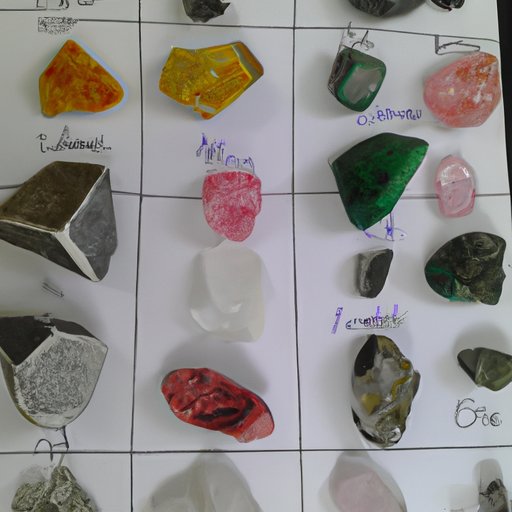Introduction
Mineralogy is a branch of science that studies minerals, their structure, physical and chemical properties, and how they form. It is a vital part of the field of geology, which focuses on the origin, history, and structure of the Earth and its environment. This article will explore the world of mineralogy, providing an introduction to the subject and examining its history, types of minerals, structure and properties, formation, role in other sciences, and importance to society.
Exploring the World of Mineralogy – An Overview
The study of minerals and their properties has been around since ancient times, with early civilizations using them for tools and ornaments. However, it was not until the 1700s and 1800s that the scientific study of minerals began to develop. The term “mineralogy” was first used by German geologist Abraham Gottlob Werner in 1789.
According to the American Geosciences Institute (AGI), “mineralogy is the study of the chemistry, crystal structure, and physical (including optical) properties of minerals.” A mineral is a naturally-occurring solid substance composed of atoms in a specific arrangement. Minerals can be either elements, such as gold, or compounds, such as quartz. There are over 4,000 known minerals, and new ones are still being discovered.

Unveiling the Mysteries of Mineralogy
The study of minerals involves examining their structure and physical and chemical properties. These properties include color, luster, hardness, streak, cleavage, fracture, and specific gravity. By studying these properties, scientists can identify and classify minerals.
In addition to studying the structure and properties of minerals, mineralogists also examine their formation. According to the AGI, “Most minerals form when molten rock cools and crystallizes, a process called magmatic differentiation. Other minerals form from hot waters circulating in cracks and cavities in rocks, a process called hydrothermal activity.” Some minerals are also formed through metamorphism, where existing rocks are changed by heat and pressure.

Examining the Role of Mineralogy in Science
Mineralogy plays an important role in the fields of geology and chemistry. In geology, mineralogy helps to understand the structure and composition of the Earth. For example, the study of minerals can help scientists determine the age of rocks and the processes that have shaped the landscape. In chemistry, mineralogy helps to identify the composition of minerals and how they interact with each other.
Dr. Alan Whittington, a professor of geological sciences at the University of Missouri-Columbia, explains: “Mineralogy is the foundation for understanding the Earth’s processes and resources. To understand how the Earth works, we must understand how minerals work.”
Understanding the Branches of Mineralogy
Mineralogy is divided into several subdisciplines, each focusing on a different aspect of the study. Crystallography is the study of the structure of crystals and the arrangement of atoms within them. Petrology is the study of the origin and composition of rocks. Economic mineralogy is the study of minerals that are economically important, such as those used in industry or jewelry. Optical mineralogy is the study of minerals under the microscope, examining their optical properties.

Investigating the Significance of Mineralogy
The study of mineralogy is important not only to scientists, but also to society. Minerals are essential for everyday life, used in everything from electronics to construction materials. Mineralogy helps us to understand the properties of minerals, allowing us to make better use of them. For example, understanding the properties of diamonds can help us to create better diamond cutting tools.
Mineralogy also has implications for the environment. By understanding the formation of minerals, scientists can better predict how they may react to certain environmental changes. This can help us to protect our natural resources and minimize the impact of mining activities.
Conclusion
Mineralogy is an important branch of science that studies minerals, their structure, physical and chemical properties, and how they form. It is closely related to the fields of geology and chemistry, and it has many practical applications in everyday life. Through the study of mineralogy, we can better understand the properties of minerals and their role in the environment.
From its beginnings in the 1700s to its modern applications, mineralogy has come a long way. As our knowledge of minerals continues to grow, so too does our appreciation for this fascinating branch of science.
(Note: Is this article not meeting your expectations? Do you have knowledge or insights to share? Unlock new opportunities and expand your reach by joining our authors team. Click Registration to join us and share your expertise with our readers.)
